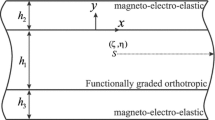Abstract
This paper discusses an in situ observation of fracture behavior around a crack tip in ferroelectric ceramics under combined electromechanical loading by use of a moiré interferometry technique. The deformation field induced by the electric field and the stress concentration near the crack tip in three-points bending experiments was measured. By analysis of the moiré images it is found that under a constant mechanical load, the electric field almost has no effect on the crack extension in the case that the directions of the poling, electric field and crack extension are perpendicular to each other. When the poling direction is parallel to the crack extension direction and perpendicular to the electric field, the strain decreases faster than that calculated by FEM with and without electrical loading as one goes away from the crack tip. In addition, as the electric field intensity increases, the strain near the crack tip increases, and the strain concentration becomes more significant.
Similar content being viewed by others
References
Mahkino Hiroaki, Kamiya Nobuo. Effects of dc electric field on mechanical properties of piezoelectric ceramics.Appl Phys A, 1994, 33: 5323–5327
Wang HY, Singh RN. Crack propagation in piezoelectric ceramics: effects of applied electric fields.J Appl Phys, 1997, 81(11): 7471–7479
Meschke F, Kolleck A, Schneider GA. R-curve behaviour of BaTiO3 due to stress-induced ferroelastic domain switching.Journal of the European Ceramic Society, 1997, 17: 1143–1149
Fu R, Zhang TY. Fracture of piezoelectric ceramics.Appl Mech Am, 1999, 7: 647–650
Park S, Sun CT. Fracture criteria for piezoelectric ceramics.J Am Ceram Soc, 1995, 78: 1475–1480
Ricoeur A, Kuna M. Influence of electric fields on the fracture of ferroelectric ceramics.Journal of the European Ceramic Society, 2003, 23: 1313–1328
Fang F, Yang W, Zhu T. Crack tip 90° domain switching in tetragonal lanthanum-modified lead zirconate titanate under an electric field.J Mater Res, 1999, 14: 2940–2944
Park SB, Park SS, Carman GP, Hahn HT. Measuring strain distribution during mesoscopic domain reorientation in a ferroelectric material.J Eng Mater Tech, 1998, 120: 1–6
Park SB, Park SS, Carman GP. Linear and nonlinear behavior of piezoelectric materials.SPIE, 1996, 2715: 366–375
Post D, Han BT, Ifju P. High Sensitivity Moiré Experimental Analysis for Mechanics and Materials. New York: Springer-Verlag, 1994
Author information
Authors and Affiliations
Additional information
The project supported by the National Natural Science Foundation of China (10132010, 10025209, 10232023)
Rights and permissions
About this article
Cite this article
Daining, F., Zhanwei, L., Huimin, X. et al. Study on fracture behavior of ferroelectric ceramics under combined electromechanical loading by using a moiré interferometry technique. Acta Mech Sinica 20, 263–269 (2004). https://doi.org/10.1007/BF02486718
Received:
Revised:
Issue Date:
DOI: https://doi.org/10.1007/BF02486718




